by Michael R. Allen
Last month my friend Emily Hemeyer invited me to contribute to a sprawling, wood-made installation called the Migratory Hive Project. The Migratory Hive Project was exhibited outdoors in Columbia, Missouri during the annual True/False Film Festival, and hopefully can find life space in St. Louis soon.

Emily assigned me the task of constructing an installation that would fit inside of a wooden box (in fact, one that we had utilized for our collaborative St. Louis Mythtory Tour in 2011). After contemplating ideas ranging from packing the box densely with parts of a soon-to-be-demolished certain former funeral home to constructing a scale model of another house inside of the box, I decided instead to curate a bit of personal pschogeography.
Landmarks
I decided to go through my archive and select photographs that I had taken of buildings in Old North St. Louis in 2005, the year that I had first really explored the area. That same year was the year that I returned from a brief residence in Chicago, and the year that I first found full-time professional employment in historic preservation (at Landmarks Association of St. Louis, a group whose name is bound to exploration of what really marks place). Exploration led to a decision to live in Old North, where I then purchased and rehabilitated a house with Claire Nowak-Boyd (who later moved to Detroit, while I moved to south city). The year 2005 is a transitory year in my life, and perhaps also for the landscape of Old North St. Louis (although only in the sense that the landscape changes every year). Several of the buildings that I photographed as a somewhat awe-inspired architectural naif would be gone within the same year; others within the next few.
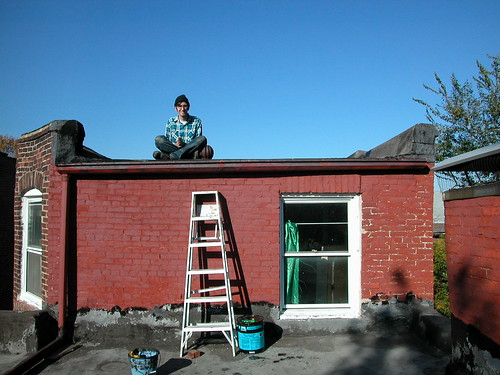
For the installation, I selected photographs of those buildings that I photographed in 2005 that are now gone. These are landmarks now only in memory, but they retain powerful significance to me. The Oxford English Dictionary defines “landmark” as “an object or feature of a landscape or town that is easily seen and recognized from a distance, especially one that enables someone to establish their location.” These buildings were landmarks then, because they defined to me the landscape of a neighborhood with which I fell in love, and they are landmarks now of both those feelings (that newness of experience, how divine!) and of the ephemeral nature of Old North or any place. The OED may not allow for metaphysical definitions, but “recognized from a distance” surely could be a temporal signifier.
The Seven Lost Buildings
My lost buildings are not all within the physical boundary of Old North as defined by official standards, but rather within a larger space mapped by my mind that includes both the neighborhood and the area across I-70 eastward where the village of North St. Louis once largely lay. My “Old North” is both historic and mental construct, related to the “actual” boundary through personal semiotic standards.
Each building has a representational nature heightened by later experience. “Distance” includes not simply time but the evolution of my professional and psychological lenses — how I now decode buildings and place them within larger systems of production and loss. Here are the buildings as I now see them.
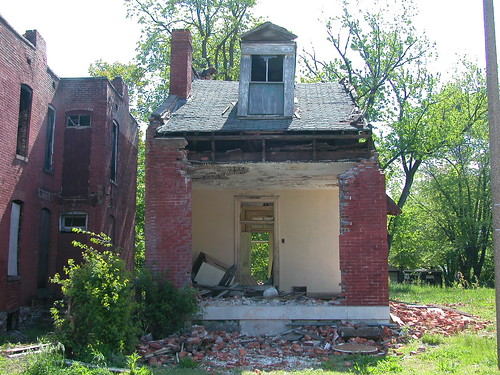
3248 N. 19th Street: The City Eats Itself. This was the first house in north city that I encountered where brick thieves had devoured parts of its walls. I had only heard stories before seeing this lonely house on 19th Street. The house was owned by the city’s Land Reutilization Authority, which had it demolished in August 2005. In the next five years brick theft would become an epidemic in and around Old North due to the increase in vacant buildings spurred by Paul J. McKee Jr.’s Northside Regeneration project.

1300-4 Hebert Street: We Arrived Too Late. In April 2005, glorious springtime led me to Dimmitt’s Confectionary at the southwest corner of Hebert and 13th streets. The building would be gone within four weeks. Demolition was not tragic given that the building had been abandoned for decades and had collapsed into itself. The land was not even worth the cost of reconstruction. Demolition just was. No doubt the building could have been economically feasible to rehabilitate, just well before my time.
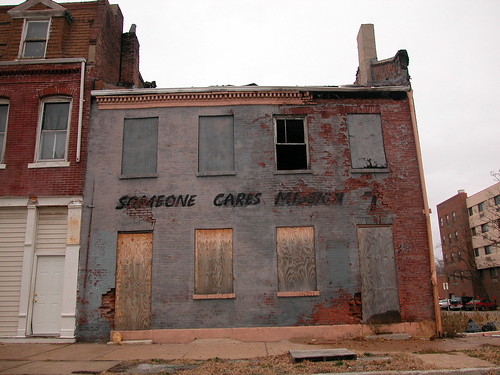
1303 Benton Street: Someone Cares But That Is Not Enough. I first spotted this near Federal style row house in 2004 — because how could an abandoned building marked with the phrase “Someone Cares” escape any photographer’s attention? I took a photograph in May 2005. The low ceiling heights and simple dentillated brick cornice date the building to the 1850s. Owned by an absentee owner in south city, the building held on surprisingly long after its roof started collapsing, only being demolished in 2010. When it finally collapsed, the land beneath it may well have sighed in relief.

1612 N. 14th Street: Urban Renewal’s Collateral Damage. When I first came across this block of 14th Street in March 2005, I thought that I stepped into a city I had never visited. On one side of the street, at each end, were the ancient (by American standards) masses of the Mullanphy Emigrant Home (1867) and the German Singing Society Building (1859). One the other side were two rows of houses — once common to the city but largely missing today — and a single residential building. The row in which this house was part seemed to date to the late 1850s or early 1860s, judging from the stone lintels, gabled roof forms and plain brick work. Yet I was not the first admirer of the site, and McKee’s companies already owned it. In 2010, the house and its northern neighbor were wrecked following fire. The block today struggles to retain its other-worldly character.
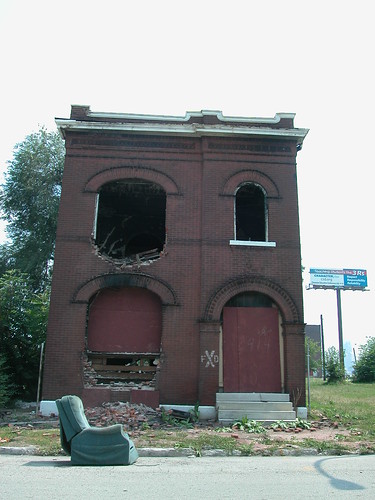
914 Madison Street: Used Up. I first encountered this Romanesque Revival two-family dwelling in August 2006. Stripped of windows and sporting brick loss, the building nonetheless showed signs of not being vacant for too long. Yet it stood isolated across the interstate from official Old North, and had an absentee owner likely praying for its demise. I assume then as I did now, that as soon as major repairs were needed the owner walked away. This building fell in 2005, and most of the other remaining dwellings in the handful of blocks east of I-70 have been erased in the following years.
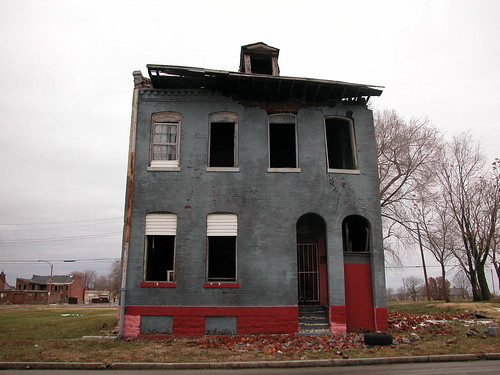
1219 Clinton Street: Last To Stand May Mean Last to Die. By the time that I first saw the Federal style brick house with Roman-arch mousehole, it was devoid of context. This was the last house on the block, and across the street was a residential development built in the 1980s. The house was not too far gone to rehabilitate, but the question shifted from the public one of preserving historic character — the block long had lost that — to the more discrete question of whether anyone cared enough to rehab the building. I took this photograph in summer 2005. The growing crack in the front wall split open following subsequent storms, and the July 2006 wind shears destroyed it. The house was wrecked late in 2006.
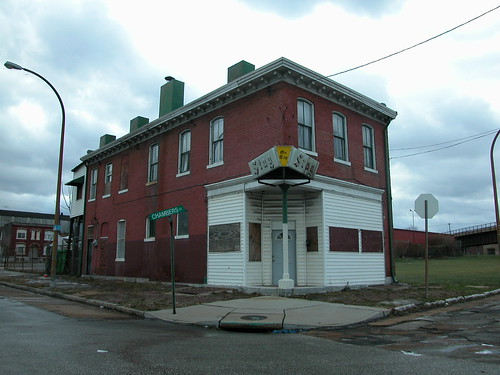
902 Chambers Street: Whodunnit: The Interstate Highway, Population Decline or a Summer Storm? One summer day in 2005, I wandered across I-70 and photographed this corner tavern building. The flounder roof form, the Italianate traits and the basically sound body were attractive. Yet the building was severed from Old North after 1954 when I-70 construction began, and its customer base shifted to the dwindling number of workers in and around North Broadway. the main neighborhood declined, the orphaned portion declined — and the building could not resist these forces. In July 2006, the tornadic south wind that sheared my own roof off led to a massive collapse of roof structure and wall here. The building was gone within a year.


2 replies on “Seven Lost Buildings in Old North”
I have enjoyed all the years you have been writing this blog. If only we could find a way not to lose so many of our structures. Retired now, for several years, I have been photo documenting many of the vernacular structures in Central KY and can now, unfortunately, count off many that are no longer. Like your artist pose fixing your roof. — barbara
Sad stuff.